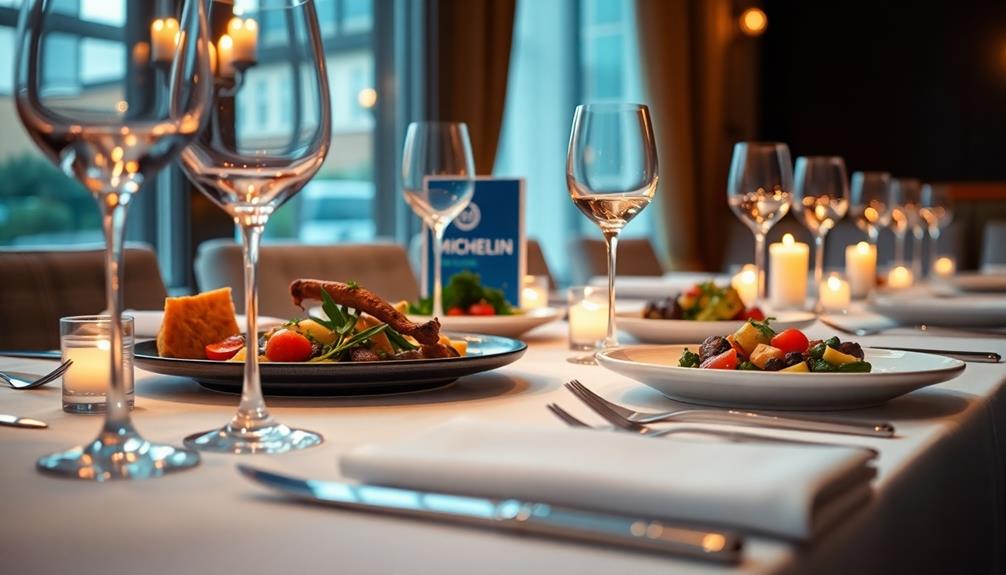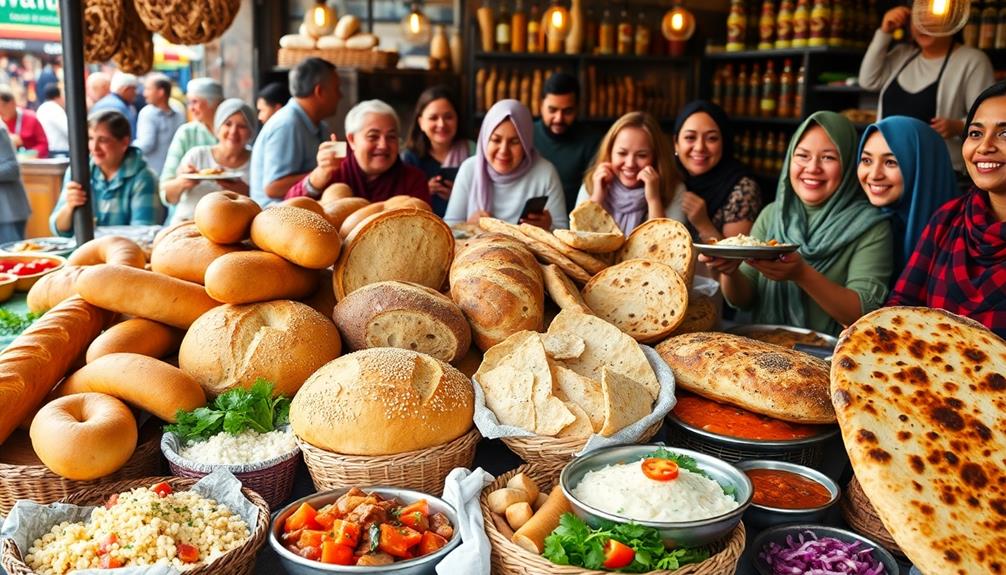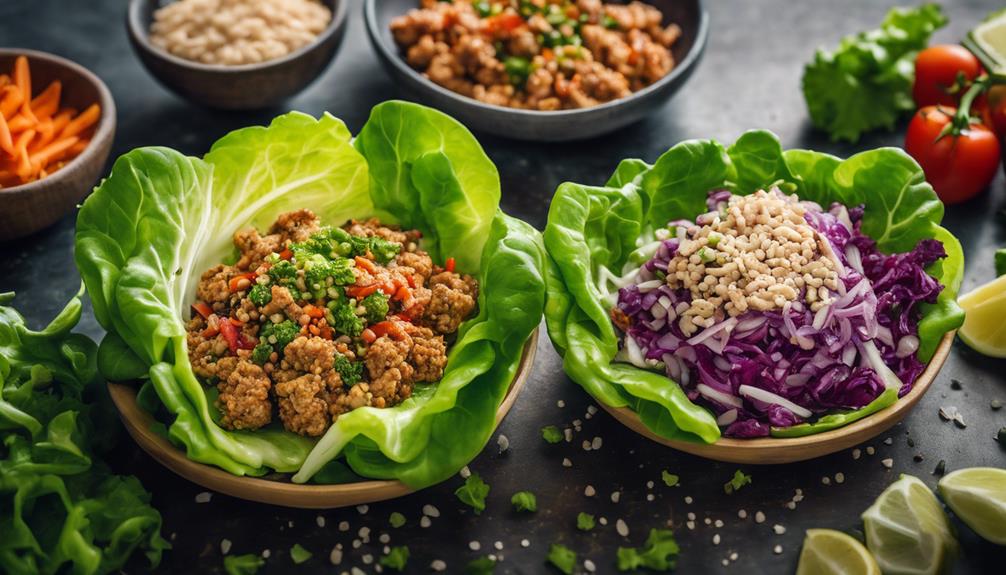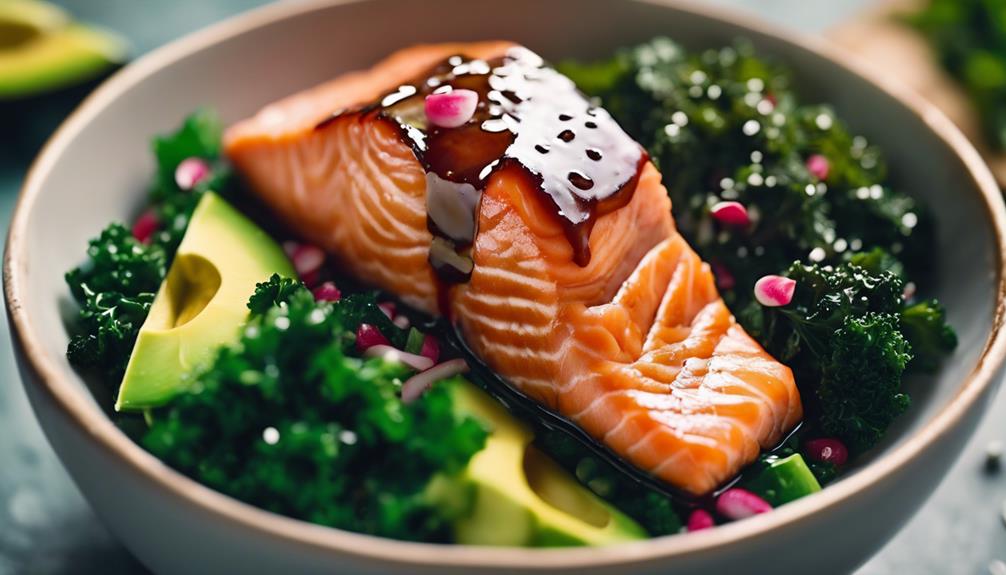Michelin Stars are awarded through a meticulous inspection process where anonymous evaluators assess restaurants multiple times. They focus on the quality of ingredients, the mastery of cooking techniques, and the harmony of flavors. Consistency is essential; inspectors need to see the same quality across visits, ensuring the restaurant maintains high standards. The star ratings range from one to three, reflecting the level of excellence. It's not just about the food, but the overall dining experience that gets evaluated. If you're curious about the impact of these stars and the challenges faced by the guide, there's more to uncover.
Key Takeaways
- Michelin Stars are awarded based on quality of ingredients, cooking techniques, and flavor harmony assessed by anonymous inspectors.
- Inspectors visit restaurants multiple times to ensure consistency and quality in the dining experience.
- The star rating system includes one star for very good, two stars for excellent, and three stars for exceptional cuisine.
- Decisions on star awards are made collectively by a team of inspectors, focusing solely on food rather than service or ambiance.
- The Michelin Guide has evolved to include other awards like Bib Gourmand and Green Star, recognizing diverse culinary experiences.
What Is a Michelin Star?
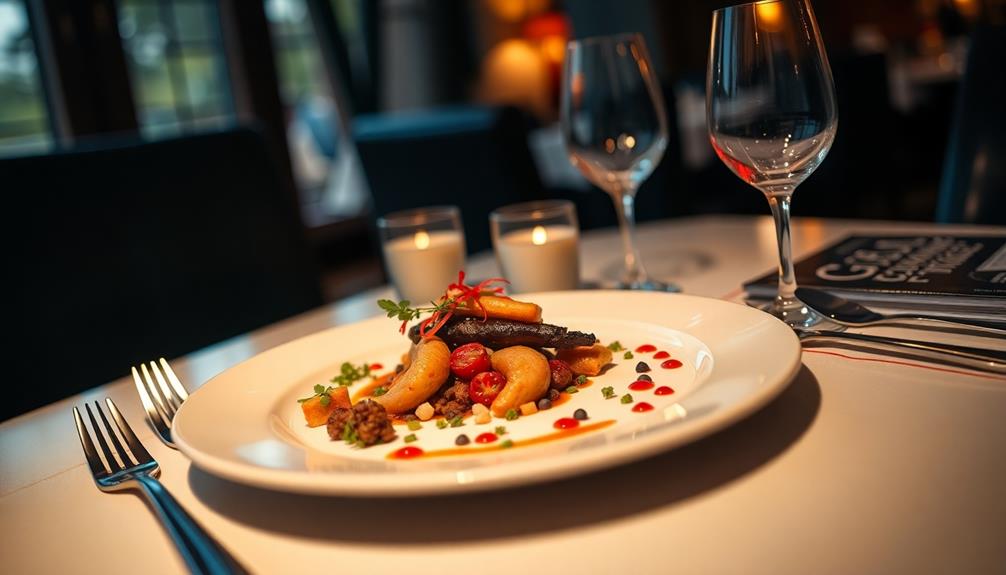
A Michelin Star is a prestigious accolade that signifies outstanding cooking and culinary excellence. It's awarded based on several criteria, including the quality of ingredients, flavor harmony, technique mastery, and the chef's personality.
As with Brazilian cuisine, where dishes like Caldeirada showcase the importance of quality ingredients and culinary tradition, the star ratings range from one to three: one star indicates very good cooking, two stars reflect excellent cuisine worth a detour, and three stars denote exceptional cooking worth a special journey.
What sets this award apart is the rigorous evaluation process carried out by anonymous reviewers known as Michelin Inspectors. They assess restaurants multiple times throughout the year to guarantee a thorough evaluation, ensuring that consistency is key.
This means that any restaurant, regardless of style or cuisine, can qualify for a Michelin Star, and the award is given to the restaurant as a whole rather than individual chefs.
Besides the Michelin Star, the guide also recognizes culinary excellence through other awards like the Bib Gourmand for affordable quality dining and the Green Star for sustainable gastronomy practices.
Achieving a Michelin Star not only elevates a restaurant's reputation but also signifies a commitment to exceptional culinary standards.
The History of the Michelin Guide

You might be surprised to learn that the Michelin Guide started in 1900, created by a tire company to encourage road travel in France.
Initially, it provided practical information for motorists, including maps and tips for car maintenance.
As the years went on, it evolved into a trusted resource for restaurant reviews, introducing a star rating system in 1931 to recognize exceptional dining, which has influenced culinary traditions worldwide, including Asian Cuisine.
Today, it's a global benchmark for culinary excellence, covering 28 countries and still shaping dining experiences.
Origins of Michelin Guide
Established in 1900, the Michelin Guide originated as a resource for promoting automobile travel and dining options, crafted by the Michelin tire company.
Initially, the guide provided drivers in France with maps, tire repair instructions, and lists of dining establishments, including various local cuisines such as Mushroom Masala that showcases rich flavors. Over the years, it rapidly expanded throughout Europe and Northern Africa, establishing itself as an essential tool for travelers.
Production of the guide was halted during World War I, but it resumed in 1920. This time, the Michelin Guide shifted to a paid model, eliminating advertisements to enhance its credibility.
To maintain high standards, the company introduced mystery diners who conducted anonymous reviews. This led to the implementation of the iconic star rating system in 1931, which initially awarded one star for fine dining and later evolved into a prestigious three-star system.
Evolution of Star Ratings
From its early days as a travel guide, the Michelin Guide has transformed considerably, particularly in how it evaluates dining establishments.
Initially published in 1900 to promote automobile travel, it introduced the star rating system in 1926. This system began with a single star for fine dining and expanded to the current three-star format in 1931, creating a prestigious measure of culinary excellence.
As gastronomy evolved, so did the appreciation for regional specialties, such as Agnolotti from Northern Italy, highlighting the importance of local ingredients and traditions in the culinary landscape.
Here are key milestones in the evolution of Michelin Stars:
- 1900: Michelin Guide first published to promote travel.
- 1926: Introduction of the star rating system.
- 1931: Expansion to three-star ratings for restaurants.
- 2005: First Michelin stars awarded to restaurants in the U.S.
- Present: Guide covers 28 countries, setting a global standard.
Michelin Stars signify culinary excellence; one star indicates a very good restaurant, two stars denote excellent cuisine worth a detour, and three stars represent exceptional cuisine worth a special journey.
The journey from the first Michelin stars to the extensive guide we see today reflects the growing importance of quality dining experiences around the globe.
Inspection Process Explained

When it comes to the Michelin inspection process, you'll find that anonymity plays a vital role. Inspectors visit restaurants multiple times, evaluating everything from ingredient quality to consistency in meals.
They pay close attention to the dishes being served, such as Red-Braised Pork Belly and Sichuan Cold Noodles, which are often benchmarks for measuring culinary excellence.
Understanding the criteria they use can shed light on what makes a restaurant worthy of a star.
Anonymous Inspector Visits
Michelin inspectors, who operate anonymously, play an essential role in the evaluation of restaurants. These full-time professionals visit establishments multiple times throughout the year to assess the consistency and quality of culinary offerings. Their anonymous visits guarantee impartiality, allowing them to evaluate without bias.
The focus on high-quality ingredients is significant, akin to how farm-to-table cooking emphasizes fresh, seasonal produce for enhanced flavor and nutrition.
During their inspections, Michelin inspectors focus on several key aspects:
- Ingredient quality
- Flavor harmony
- Technique mastery
- The chef's personality
- Consistency across visits
They don't consider ambiance or service quality in their reports, concentrating solely on the food. By sampling a wide range of dishes during multiple visits, inspectors provide an extensive evaluation of the restaurant's culinary offerings.
After these visits, decisions about Michelin Star awards are made collectively by a team of inspectors. They discuss their findings and individual reports, contributing to the credibility of the Star rating system.
This anonymous evaluation process not only maintains the integrity of the Michelin Guide but also highlights the importance of quality in the dining experience. Ultimately, the dedication of Michelin inspectors guarantees that only the best restaurants receive recognition for their culinary excellence.
Evaluation Criteria Overview
The evaluation criteria for Michelin Stars hinge on a meticulous inspection process that prioritizes the quality of food over other factors. Michelin inspectors, who remain anonymous, visit restaurants multiple times throughout the year, sampling a variety of dishes to guarantee a thorough assessment of culinary excellence.
This rigorous evaluation can include a diverse range of cuisines, such as the delicate flavors found in traditional Japanese confectionery, like dorayaki, which showcases a chef's attention to detail and skill.
Key aspects of the evaluation criteria include the quality of ingredients and the mastery of cooking techniques. Inspectors pay close attention to the harmony of flavors, guaranteeing each dish reflects a chef's skill and creativity.
While service and ambiance are important in the dining experience, they're not officially considered in the star ratings.
Consistency is paramount; restaurants must demonstrate reliable quality across multiple visits. This means that Michelin Stars are awarded based on more than just a single exceptional meal.
After thorough discussions, the inspectors make collective decisions, guaranteeing an impartial evaluation grounded solely in food quality.
The star system itself is telling: one star signifies very good cooking, two stars denote excellent cuisine worth a detour, and three stars represent exceptional cuisine worthy of a special journey, reflecting the restaurant's overall culinary excellence.
Consistency Across Meals
Guaranteeing consistency across meals is vital in the Michelin inspection process. Michelin inspectors visit restaurants multiple times throughout the year, sampling a variety of dishes to evaluate the quality and flavor.
They're anonymous professionals with extensive backgrounds in hospitality and culinary arts, which helps guarantee impartial assessments. For instance, they might assess a restaurant that serves traditional dishes like Chilaquiles or Cochinita Pibil to verify that each preparation meets high standards.
Inspectors look for a high standard of execution in every meal, as delivering consistent quality is imperative for a restaurant to be in the running for a star. They analyze not just individual dishes but the overall dining experience, paying close attention to:
- Harmony of flavors
- Mastery of culinary techniques
- Presentation of each dish
- Service quality
- Ambience and atmosphere
After their visits, inspectors engage in collective discussions, sharing observations and opinions to reach a consensus on the restaurant's overall performance.
This thorough evaluation process underscores the importance of consistency and quality, as only those establishments that maintain excellence across multiple meals can hope to earn that coveted Michelin star.
Criteria for Awarding Stars

Awarding Michelin Stars relies on several key criteria that evaluate the essence of a restaurant's culinary offerings. Inspectors focus on the quality of ingredients used and how they contribute to the overall dish. For instance, many Southern comfort foods, like squash casserole, highlight the importance of fresh, flavorful ingredients that enhance the dining experience.
You'll find that excellent cooking techniques are vital, as they showcase the chef's mastery and elevate the dining experience. The harmony of flavors in your plate is also paramount, guaranteeing that every bite is a delight. To achieve this, chefs must carefully select and combine ingredients, ensuring that each component complements the others. Whether it’s a delicate balance of sweet and savory or a bold contrast of spicy and tangy, the harmony of flavors is what makes a dish truly memorable. When done right, this attention to detail can turn even the simplest dish into a culinary masterpiece, like a tasty Halloween finger food that leaves a lasting impression on guests.
Consistency across multiple visits is essential; inspectors assess whether the restaurant maintains high standards over time. It's not just about one perfect meal, but rather a commitment to delivering exceptional culinary experiences consistently.
The Michelin Stars system uses a three-star scale: one star signifies very good cooking, two stars mark excellent cuisine worth a detour, and three stars indicate exceptional cooking worth a special journey.
Anonymous inspectors conduct thorough evaluations, focusing solely on the food, not on ambiance or service. Their detailed reports highlight the chef's creativity and personality, contributing to the impartiality of the evaluation process.
Ultimately, the criteria for awarding stars guarantee that only the finest culinary establishments receive Michelin recognition.
Understanding Star Ratings

Michelin Star ratings serve as a prestigious benchmark in the culinary world, guiding diners to exceptional dining experiences. Understanding these star ratings can enhance your culinary journey and help you appreciate what makes a restaurant truly remarkable.
The Michelin system employs a three-tiered approach:
- One Star: A very good restaurant in its category.
- Two Stars: Excellent cooking worth a detour.
- Three Stars: Exceptional cuisine worth a special journey.
To earn these coveted stars, restaurants must excel in various areas. Inspectors evaluate the quality of ingredients and the mastery of cooking techniques. They also look for harmony of flavors and consistency across multiple visits, ensuring that the dining experience remains high-quality over time.
Significantly, just as traditional Ethiopian dishes like Yekolo highlight the importance of ingredient quality and preparation, Michelin Star restaurants must also prioritize these elements.
It's important to emphasize that Michelin Stars reflect the restaurant as a whole rather than individual chefs.
Furthermore, culinary education plays a role, as many chefs and teams trained in Michelin-rated establishments understand the standards required to achieve and maintain star status.
Impact of Michelin Stars

Earning a Michelin star can dramatically change a restaurant's trajectory. When a restaurant receives one of these prestigious Michelin Stars, its visibility skyrockets, leading to a surge in reservations and revenue. Statistics reveal that those awarded two or three stars can see up to a 20% increase in business following the announcement of their restaurant rating.
This newfound attention often translates into culinary tourism, as food enthusiasts flock to experience the quality of service and consistently high standards that Michelin Stars represent.
However, the pressure to maintain these expectations can be intense. Customers expect nothing less than excellence, and any dip in food quality or service can lead to disappointment. Losing a Michelin star can be detrimental, resulting in a decline in reputation, revenue, and media interest.
In regions with Michelin-starred restaurants, you'll notice a shift in dining trends as they become destinations for culinary tourism. Diners actively seek out these establishments, making Michelin Stars not just a mark of quality but also an essential piece of consumer information that shapes the dining landscape.
Ultimately, the impact of Michelin Stars extends far beyond the restaurant itself.
Alternative Michelin Awards
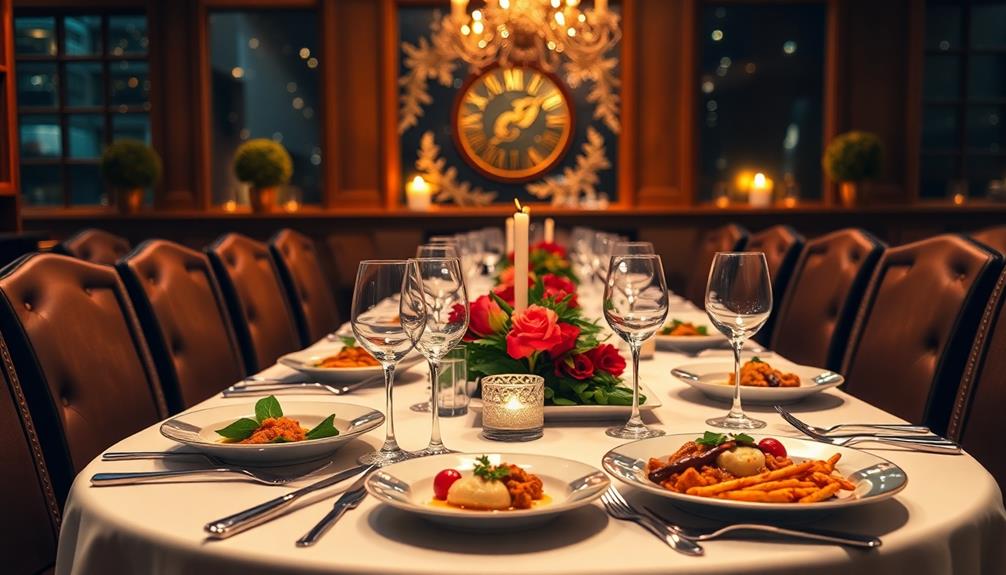
While many people associate the Michelin Guide solely with its prestigious stars, there are several alternative awards that highlight different aspects of culinary excellence. These recognitions expand the scope of what defines exceptional dining experiences, catering to a wider audience.
- Bib Gourmand: Awarded since 1957, it highlights restaurants offering high-quality meals at reasonable prices, typically a three-course meal below a specific price point.
- Michelin Plate: This award recognizes establishments serving good food that may not meet the criteria for a star, acting as an entry point for those aspiring to higher accolades.
- Green Star: Introduced in 2020, this honor is for restaurants committed to sustainable gastronomy practices, showcasing a focus on ethical and environmentally friendly culinary methods.
- Value and Quality Emphasis: The Bib Gourmand is particularly popular among diners for its focus on value without compromising quality.
- Evolving Recognition: The Michelin Guide continues to adapt, incorporating these alternative awards to recognize a broader range of dining experiences beyond traditional fine dining.
These awards highlight the diversity of culinary talent and the commitment to quality, sustainability, and value in the food industry.
Challenges Faced by the Guide

Maneuvering the culinary landscape, the Michelin Guide faces significant challenges that affect its reputation and relevance. Critics argue that the guide often favors Michelin Star Restaurants that lean towards fine dining, overlooking casual eateries and diverse culinary styles. This perceived bias raises questions about the guide's commitment to represent the vibrant variety of global cuisine.
The subjective nature of the ratings also fuels debate. Inspectors' personal preferences can clash with contemporary dining trends, leading to concerns that the guide may not accurately reflect the evolving food scene.
While the recognition of hawker stalls in Singapore in 2016 was a step toward embracing diversity, ongoing discussions about regional representation persist, highlighting the need for a broader scope in culinary recognition.
Moreover, there's the pressure that comes with maintaining a Michelin star. Chefs might feel stifled, hesitant to experiment with new ideas for fear of losing their hard-earned accolade. This pressure can ultimately hinder creativity, making it difficult for chefs to push culinary boundaries and innovate within their craft.
Addressing these challenges is essential for the Michelin Guide to remain relevant in the ever-changing world of gastronomy.
Global Influence of Michelin Stars

The global influence of Michelin Stars is undeniable, shaping dining trends and restaurant reputations in culinary capitals like New York, Tokyo, and Paris. When a restaurant earns a Michelin Star, it often transforms into a culinary destination, attracting food enthusiasts from around the world.
This prestigious award not only recognizes fine dining but also embraces diverse culinary styles, as seen with hawker stalls in Singapore.
Here's how Michelin Stars impact the culinary landscape:
- Increased visibility: Restaurants often see a surge in media attention and foot traffic.
- Longer reservation wait times: Gaining a Michelin Star can lead to fully booked tables for months.
- Career influence: Chefs aim for Michelin Stars to boost their careers and reputations.
- Benchmark for excellence: The star system serves as a standard for culinary achievement globally.
- Diverse recognition: The guide's expansion highlights inclusivity in cuisine, celebrating all forms of culinary excellence.
In this way, Michelin Stars continue to wield significant global influence, driving dining trends and encouraging chefs and restaurants to pursue higher standards of excellence.
Frequently Asked Questions
How Are Michelin Stars Determined?
Michelin stars are determined by evaluating a restaurant's food quality, flavor, technique, and consistency. Inspectors visit multiple times, ensuring each aspect meets high standards, leading to a consensus on the restaurant's culinary excellence.
Are Michelin Star Inspectors Secret?
Imagine a ghost in the kitchen, tasting dishes without revealing their presence. Michelin inspectors are indeed secretive, dining incognito to assess restaurants fairly, ensuring their evaluations remain confidential until the guide's release.
Who Decided Who Gets a Michelin Star?
You might wonder who decides who gets a Michelin Star. It's a collective effort by seasoned inspectors, who evaluate restaurants based on consistent quality, flavor, and overall dining experience before making their final decisions together.
Can You Get a 5 Star Michelin?
Imagine chasing culinary rainbows, but you won't find a five-star Michelin. The Michelin Guide caps at three stars, symbolizing the pinnacle of dining excellence. So, no, you can't earn a five-star Michelin rating.
Conclusion
In the world of culinary excellence, Michelin stars are like golden tickets to gastronomic fame. They open doors and create opportunities, but remember, not every exceptional restaurant basks in their glow. While the journey to starry recognition is a rigorous one, it's the heart and soul behind each dish that truly matters. So, whether you're chasing stars or savoring hidden gems, keep exploring the delightful tapestry of flavors that awaits you on every plate.
